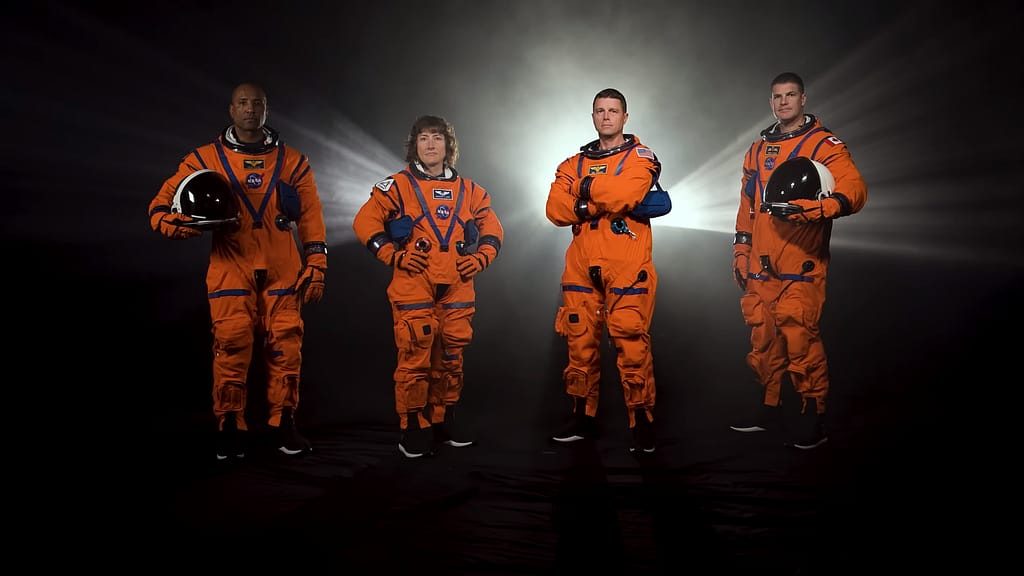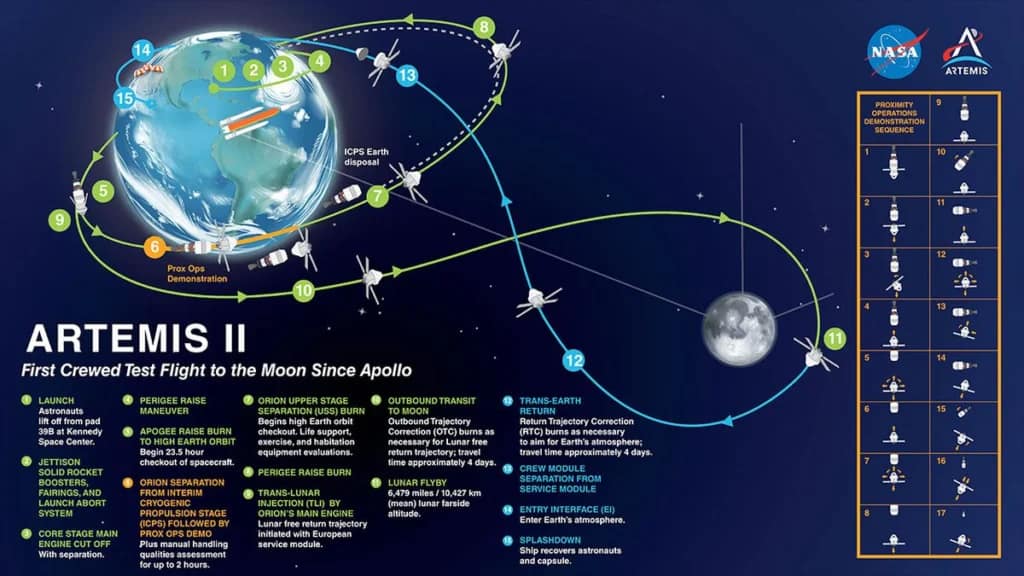The Moon landing conspiracy theory has intrigued many for years, but NASA is leaving no room for such speculations any more. The space agency is embarking on the Artemis mission, the first crewed mission to the Moon since Apollo 17 in 1972. The Artemis program is setting the stage for humanity’s return to our celestial neighbor, with Artemis 2 as a pivotal step in this remarkable journey.
Artemis Mission: A Three-Stage Odyssey
The Artemis mission unfolds in three stages, with the first stage, Artemis 1, dedicated to testing the Orion module and the ICPS (Interim Cryogenic Propulsion Stage) around the Moon. However, Artemis 2, the focus of our exploration, is the second stage of this ambitious mission. Scheduled for launch in 2024, Artemis 2 is set to be a historic mission, as no woman has yet set foot on the Moon. The name ‘Artemis’ is a tribute to the Greek goddess of hunting, nature, and chastity, symbolizing a protective spirit towards women, children, and childbirth. This mission promises to be distinctly different from its predecessor, Apollo.
Artemis 2: A Mission of Exploration and Preparation
Artemis 2 is characterized by anticipation and excitement. The mission’s objective is to prepare for future lunar missions with the ultimate goal of establishing a sustainable human presence on the Moon. In 2024, four astronauts will embark on a return trip to the Moon aboard the Orion spacecraft. Their mission will involve studying the lunar environment, demonstrating new technologies, and contributing to the foundation of a long-term lunar presence.
In sharp contrast to the historic Apollo missions, which aimed to explore the lunar surface and conduct various experiments, the Artemis mission is primarily focused on establishing a sustainable lunar base and advancing human exploration beyond the Moon, particularly toward Mars. This shift in focus highlights NASA’s commitment to long-term space exploration and colonization.
A fundamental difference lies in the crew capacity, as the Orion spacecraft can accommodate four astronauts, in contrast to the Apollo missions, which typically had three astronauts. The increased crew size allows for more comprehensive scientific investigations and enhances the mission’s overall capabilities.
The Artemis II Astronauts
The Artemis II crew comprises four accomplished astronauts:

- Reid Wiseman (Commander): Reid Wiseman is set to lead the Artemis II mission. He will oversee the crew’s activities and decision-making during the journey.
- Victor Glover (Pilot): Victor Glover will serve as the pilot for Artemis II, responsible for the spacecraft’s navigation and control.
- Christina Koch (Mission Specialist): Christina Koch’s role as a mission specialist will involve conducting scientific experiments and tasks during the mission.
- Jeremy Hansen (Mission Specialist): Jeremy Hansen, another mission specialist, will contribute to various aspects of the mission’s success.
The Inspiration Behind Artemis II
The crew members of Artemis II, like many of us, have been inspired by the profound impact of previous lunar missions, particularly the iconic “Earthrise” photo taken during Apollo 8. This image, captured by humans orbiting the Moon, forever altered our perspective on Earth and our place in the universe.
The Moon is not just a symbol of exploration but also a beacon for scientific discovery. It holds vital clues about the origins of our solar system and life on Earth. The Artemis program’s objective is to build upon the legacy of Apollo and continue the exploration of this celestial neighbor.
The Journey to the Moon: A Faster and Safer Approach
Artemis 2 Mission promises a swifter and safer journey to the Moon, thanks to the Interim Cryogenic Propulsion Stage (ICPS). Unlike the Apollo missions, which relied on Earth’s gravitational pull to reach the Moon, Artemis 2 will rely solely on the ICPS for propulsion, enabling a more expedited journey. This approach keeps the crew safely outside the Van Allen radiation belts, which surround Earth. To ensure the astronauts’ protection from radiation and space debris, the Orion spacecraft is equipped with a double layer of aluminum and Kevlar. This layered protection system provides an efficient defense against radiation, ensuring the crew’s safety.
The journey through the Van Allen belts, a region filled with high levels of radiation, will take less than two hours, thanks to the spacecraft’s inertial and gravitational forces. This efficient approach minimizes the astronauts’ exposure to radiation, significantly reducing the risk of long-term health problems such as cancer.
Despite these precautions, some radioactive particles may still reach the astronauts’ bodies. The radiation doses in such cases are relatively mild, but the mission team minimizes the astronauts’ time within the Van Allen belts to ensure their safety. NASA’s valuable experience from the Apollo missions has been instrumental in shaping the Artemis missions, reflecting a legacy that will provide an opportunity for a new generation to witness a live lunar landing.
Key Distinctions Between Apollo and Artemis
Artemis and Apollo, while sharing some similarities, have distinctive characteristics that set them apart. One significant difference is the crew capacity, with the larger Orion spacecraft accommodating four astronauts, as opposed to Apollo’s three. The 316 cubic feet of additional space in Orion allows for an expanded crew, enhancing the mission’s capabilities.
The historical context also distinguishes these programs. The Apollo missions were driven by political competition, as the United States and the Soviet Union engaged in a space race during the 1960s. This era witnessed the rapid succession of lunar landings. In contrast, the Artemis missions are designed for a more sustained lunar presence, focusing on extended-term missions, lunar bases, and an orbital gateway. Artemis is driven by scientific exploration and a commitment to creating a sustainable lunar economy.
Technology plays a pivotal role in differentiating the two programs. Orion boasts advanced technology, with two redundant flight computers, each consisting of two redundant computing modules, offering greater reliability. Orion’s computing capabilities surpass Apollo’s with 128,000 times more memory and a processing speed 20,000 times faster.
Another notable distinction is the launch system. While the Saturn V rocket had three stages, the Space Launch System (SLS) used a powerful central stage with two solid rocket boosters and the Interim Cryogenic Propulsion Stage (ICPS) to propel the Orion spacecraft. The SLS, with its 15% greater thrust than the Saturn V, is the tallest rocket component globally and serves as the backbone of the launch system.
Radiation Shielding: Ensuring Astronaut Safety
One of the critical aspects of the Artemis program is ensuring astronaut safety during the journey through the Van Allen belts. The Orion spacecraft employs a multi-layered shielding system to protect astronauts from radiation exposure. This system includes an Advanced EMF Radiation Shielding system, an Active Magnetic Shielding System, and a Layer of Ceramic Plating. These protective layers work in concert to absorb and deflect radiation away from the astronauts.
By limiting the time spent in the radiation zone and employing advanced shielding, the mission team is confident that the astronauts will remain safe and healthy during their journey. The mission will culminate in the historic return of two astronauts to Earth after nearly half a century, marking a new chapter in lunar exploration.

Conclusion: A New Era in Lunar Exploration
As we anticipate the launch of Artemis 2 in 2024, we are witnessing a remarkable evolution in space exploration. The Artemis program is not merely a sequel to Apollo but a symbol of NASA’s commitment to long-term lunar exploration, the establishment of lunar bases, and the preparation for missions to Mars and beyond.
Artemis 2, with its distinctive features and ambitious goals, embodies the spirit of exploration and discovery that has driven human spaceflight for decades. This mission is not only a testament to technological advancement but a promise of a brighter future for space exploration and colonization. The Artemis generation will stand on the shoulders of giants, honoring the legacy of Apollo while paving the way for a new era of lunar exploration.




